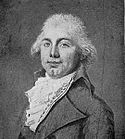1790–91 United States Senate elections
Senators were elected over a wide range of time throughout 1790 and 1791, and a seat may have been filled months late or remained vacant due to legislative deadlock.Members are informally grouped into factions of similar interest, based on an analysis of their voting record.William Samuel Johnson resigned March 3, 1791, at the end of the 1st Congress and Roger Sherman was elected June 13, 1791, to finish the term.Charles Carroll won re-election over Uriah Forrest by a margin of 20.00%, or 15 votes, for the Class 1 seat.Besides, the Livingston faction of the Federalist Party felt betrayed after the election of Rufus King over their candidate James Duane in 1789, and now allied themselves with Clinton and later became Democratic-Republicans.[13] As a result of this congressional schedule Bradley and Robinson had not been seated when the Vermont House of Representatives convened in early October, 1791.[12] At this legislative session, some members suggested that the January election of Bradley and Robinson had been premature, since Vermont had not yet been admitted to the union.
1788 & 17891792 & 1793United States SenatePro-AdministrationAnti-AdministrationU.S. Senatemidterm election cycleGeorge WashingtonSeventeenth Amendmentstate legislatureslegislative deadlockClass 1Anti-Administration Partyelections in Rhode IslandelectedTheodore FosterJoseph Stanton Jr.John WalkerJames MonroeWilliam PatersonGovernor of New JerseyPhilemon DickinsonOliver EllsworthGeorge Readre-electedCharles CarrollTristram DaltonNathaniel GorhamGeorge CabotNathan DaneSamuel HoltenJonathan ElmerJohn RutherfurdPhilip SchuylerAaron BurrEgbert BensonWilliam Maclay1790 (special)William S. JohnsonRoger ShermanMoses RobinsonStephen R. BradleyList of United States senators from ConnecticutWilliam Samuel Johnson1st Congress1790 United States Senate election in DelawareList of United States senators from DelawareList of United States senators from MarylandMaryland General AssemblyUriah ForrestFederalistList of United States senators from MassachusettsTristam DaltonMassachusetts Provincial CongressIndependentList of United States senators from New Jersey1791 United States Senate election in New YorkList of United States senators from New YorkNew York State Legislature14th New York State LegislatureGeorge ClintonFederalist PartyNew York State Attorney GeneralDemocratic-Republican PartyAlexander HamiltonU.S. Secretary of the TreasuryLivingstonRufus KingJames DuaneDemocratic-RepublicanU.S. senatorState SenateState Assembly1791 United States Senate election in PennsylvaniaList of United States senators from PennsylvaniaList of United States senators from Rhode IslandList of United States senators from VermontVermont House of RepresentativesGovernor1st United States Congress2nd United States CongressList of United States senators from Virginia1790 United States House of Representatives elections in VirginiaWilliam Grayson1790 United States elections1790–91 United States House of Representatives electionsTufts UniversityJabez Delano Hammond1789←DelawareMassachusettsNew JerseyNew Jersey (special)Rhode IslandVirginia (special)U.S.HouseConnecticutAt-large spMarylandNew HampshireNew YorkNorth CarolinaAugust 1790October 1790South CarolinaVirginia5th spPennsylvaniaUnited States Senate elections1788–19131788–891792–931794–951796–971798–991800–011802–031804–051806–071808–091810–111812–131814–151816–171818–191820–21